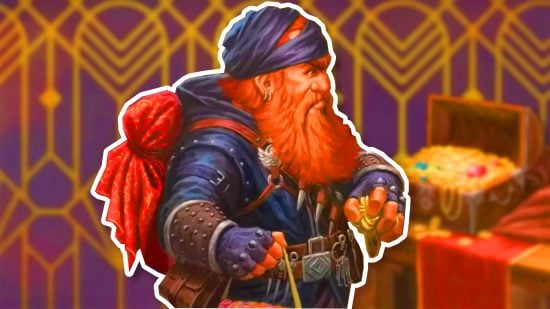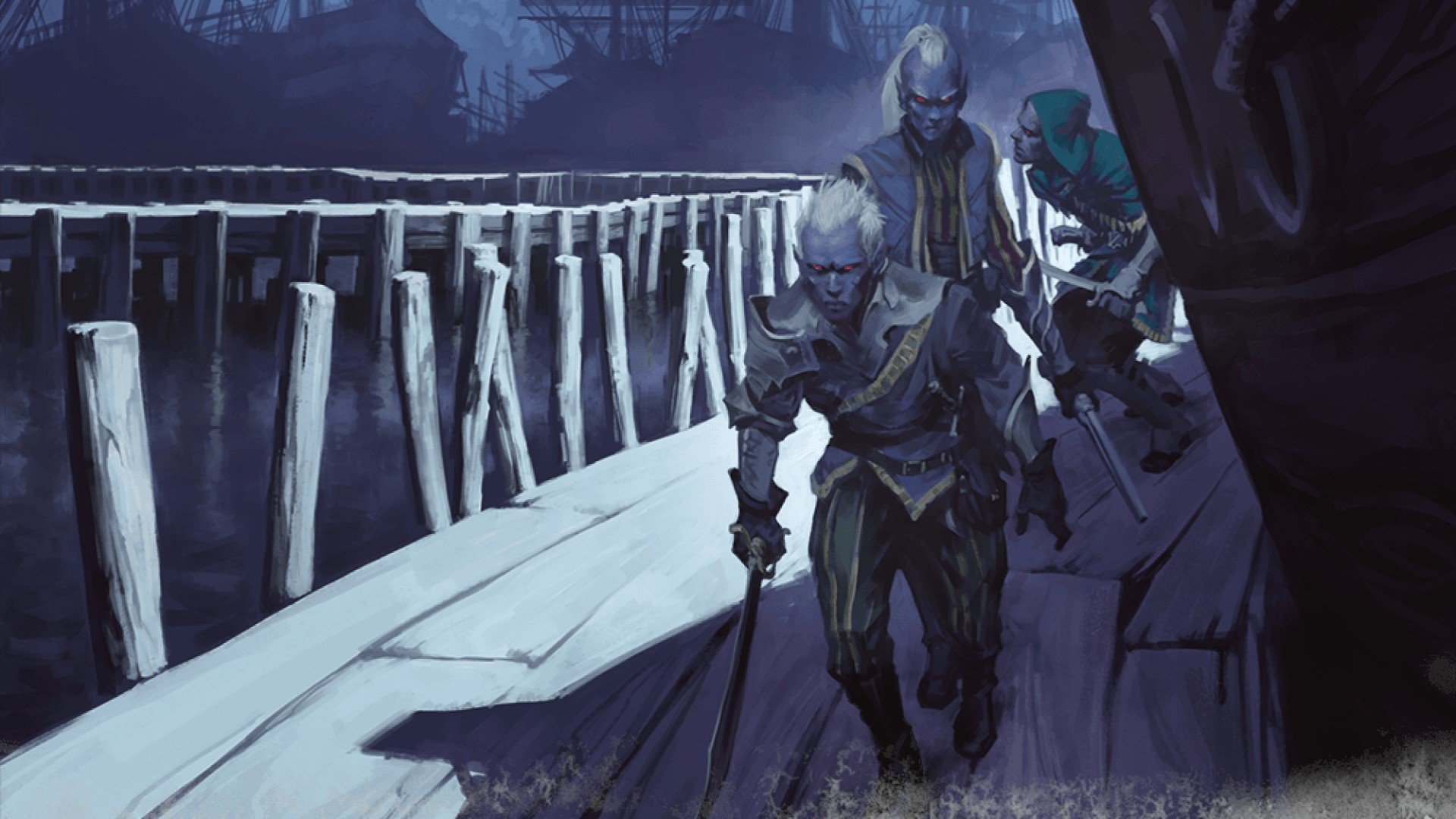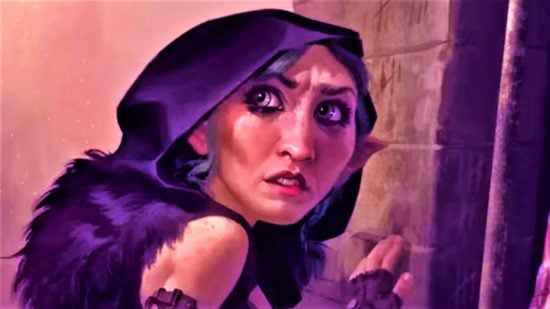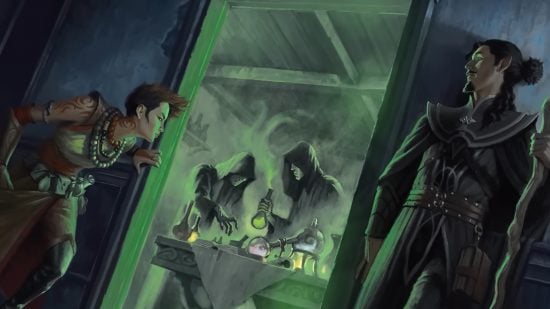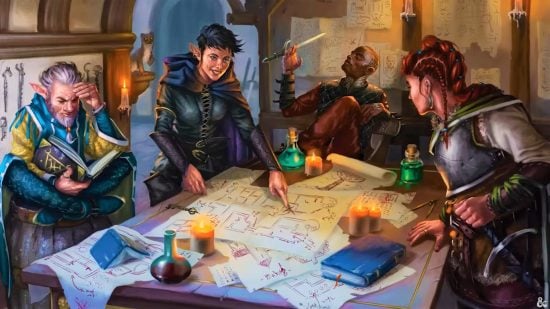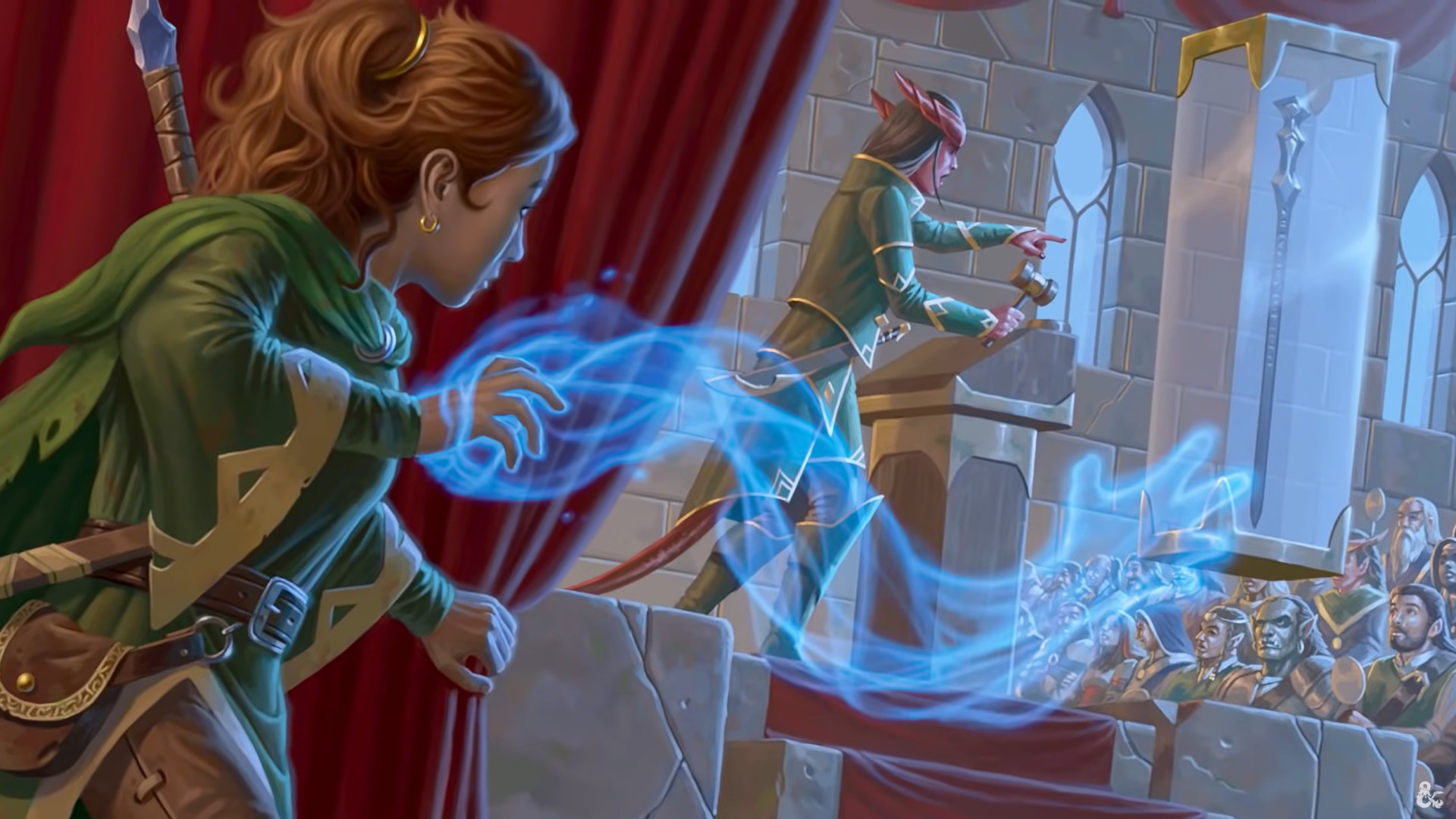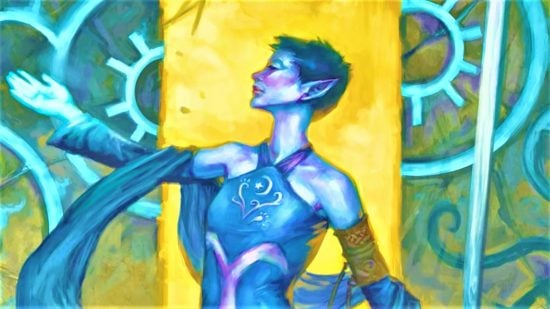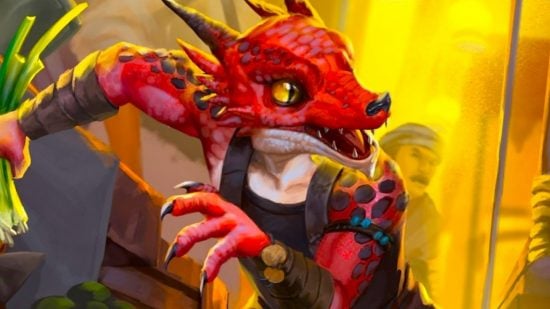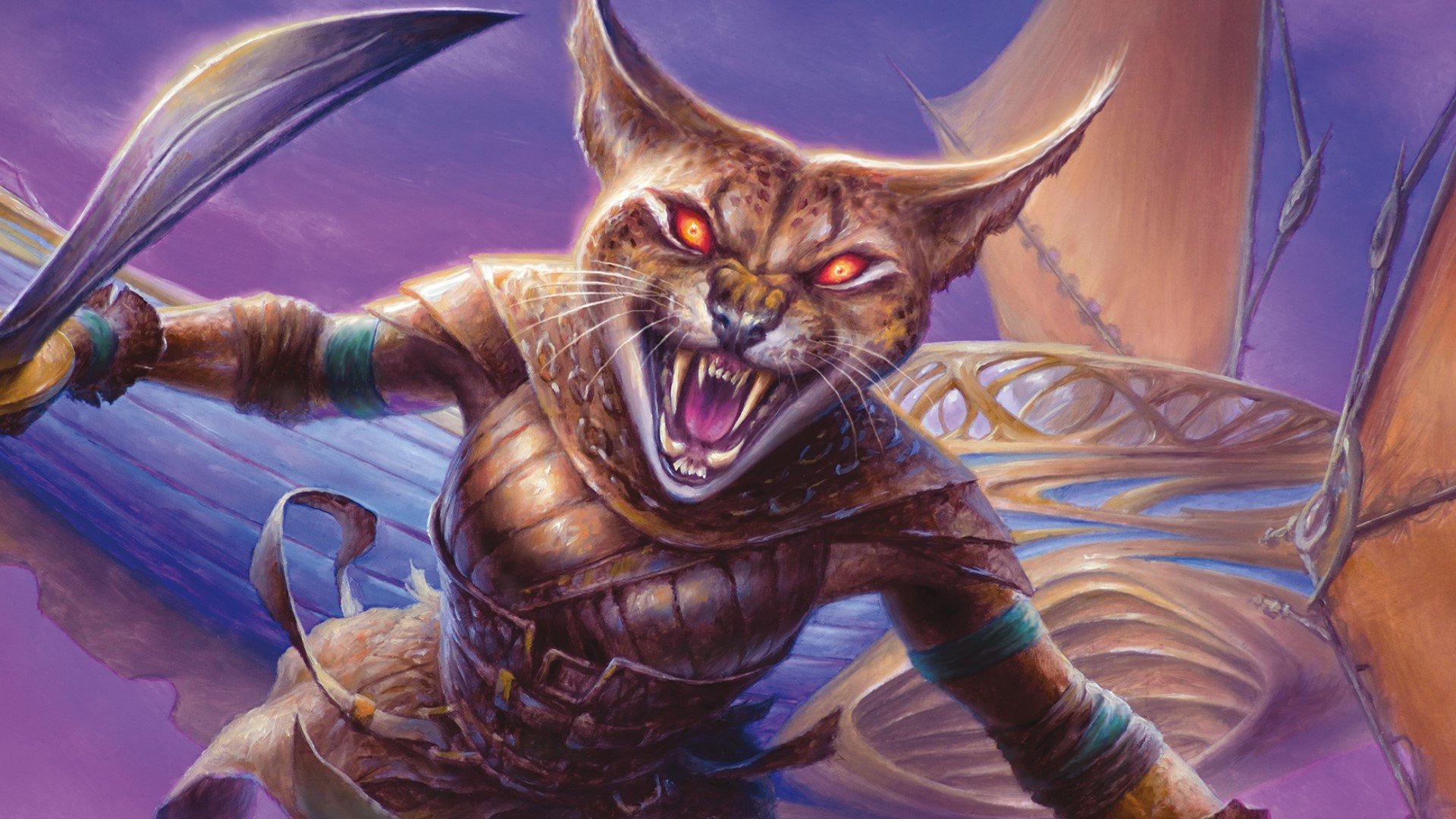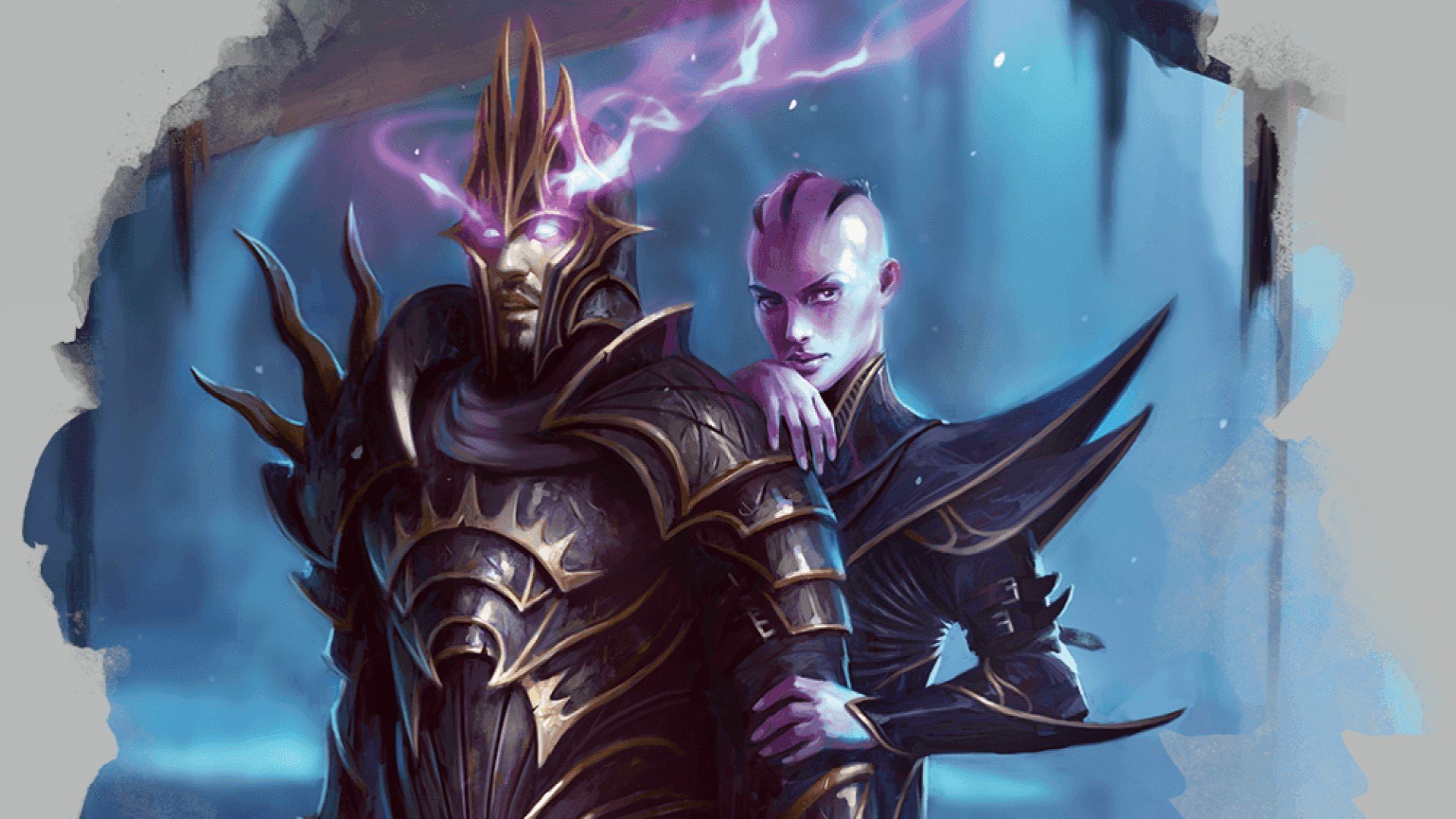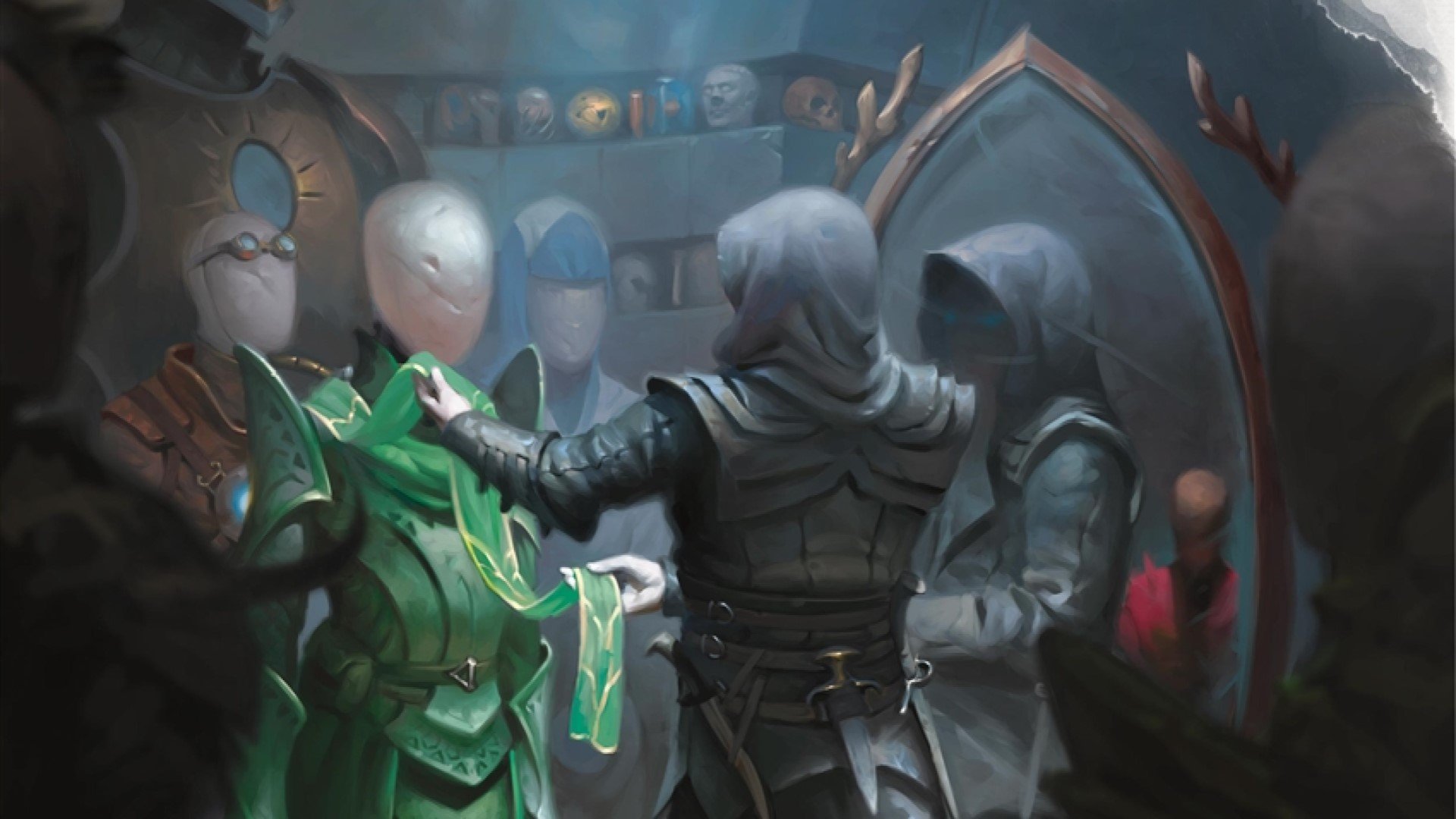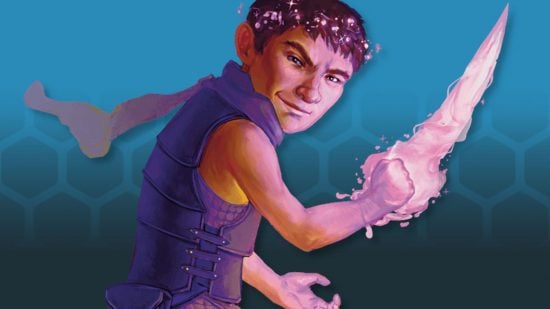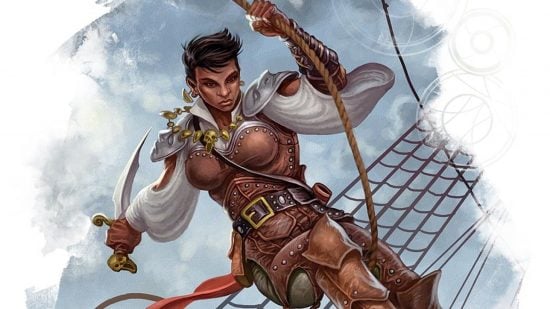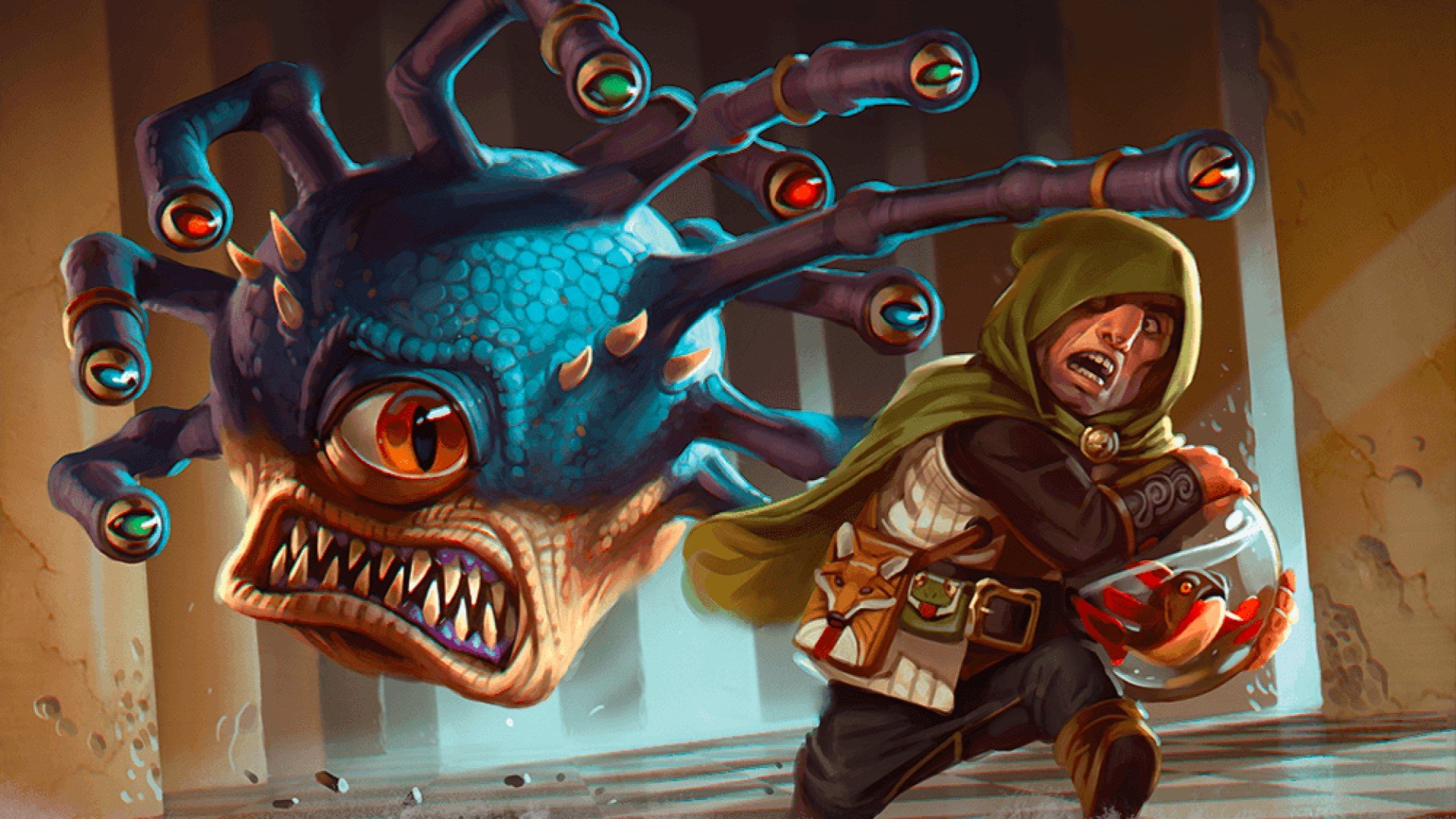The DnD Rogue has been a popular class choice since the earliest days of Dungeons and Dragons, and for good reason. It presents a wealth of different play options, allowing you to be a dashing thief in one game, a grim assassin in the next, and then a spirit medium or swashbuckling pirate. With the Rogue 5e class, you have your pick of spells, skills, and sneaky attacks – and any party will be glad to have you.
This guide is a deep dive into the shadows, giving you everything you need to form your DnD 5e Rogue character. We’ll cover the core DnD stats and help you choose the right DnD background and DnD skills for your next campaign. We’ll also break down each of the tantalizing Rogue subclasses 5e has to offer.
If you’ve still not decided which class to play in your next campaign, try our DnD classes guide to get you started. For the easiest possible creation process, you should also read our guides to DnD races, DnD character sheets, and free online DnD character creator tools. If you’re already hooded and skulking, though – read on.
Here’s our DnD Rogue 5e class guide:
- Rogue 5e stats
- Rogue 5e class features
- Best Rogue 5e races
- Rogue archetypes
- Rogue 5e builds
- One DnD Rogue
Rogue 5e stats
Here are the core Rogue 5e stats for your character:
| Hit dice | 1d8 Per Level |
| HP at lvl up | 1d8 [or five] + Constitution modifier |
| Primary ability score | Dexterity, then Intelligence, Charisma or Wisdom |
| Armor proficiency | Light Armor |
| Weapon proficiency | Simple Weapons, Hand Crossbows, Longswords, Rapiers, Shortswords |
| Tool proficiency | Thieves’ Tools |
| Saving throws | Dexterity, Intelligence |
Dexterity is the king of stats for the Rogue. You’ll spend your adventuring career wearing light DnD armor, so your Dex bonus is critical to boosting your armor class and keeping your insides where they belong. Rogues can only make Sneak Attacks using ranged or finesse melee DnD weapons, so Dexterity will govern your attack bonus and boost your damage output.
And, if that wasn’t enough, Dexterity controls the Stealth, Acrobatics and Sleight of Hand skills, a useful toolbox that will help you remain undetected, get to places you shouldn’t be, and then pilfer stuff when you get there. Make sure to maximize your Dexterity at every opportunity.
What you prioritize next will depend on your subclass. The Arcane Trickster needs Intelligence to power her spells, the Inquisitive uses Wisdom to survive inside and outside combat, while the Swashbuckler benefits from a high Charisma score. Other Rogue subclasses don’t rely on a secondary ability as heavily to be combat effective, so you can be guided by what you want to do outside combat.
There isn’t a natural ‘dump’ stat for the Rogue. Charisma makes a Rogue into a silver-tongued liar, charming rascal, or intimidating villain. Extra hit points from a Constitution bonus are welcome for such a lightly-armored class.
At low levels, a single hit point can be the difference between life and death, and from level five your Uncanny Dodge ability means that, if you’re only hit once per turn, your hit points will last twice as long as everyone else’s.
Wisdom boosts the Perception and Insight skills, which are key abilities if you want a Rogue who can root out secrets, whether that’s a hidden stash of loot or a character who’s lying to you. Though you don’t use Strength for your melee attacks, it controls the Athletics skill, which Rogues often use when they’re climbing walls, or jumping into the canal to swim away from the law.
Resist the temptation to make a jack of all trades – work out what’s most important to your character, and accept that committing to it means being weaker in other areas.
Hiding
As Rogues spend so much of their time evading detection and get so much benefit from making attacks that ambush their enemy, it’s worth talking with your DM to check you are on the same page about how the ‘stealth’ skill actually works.
A simulation-loving DM might only allow you to attempt to use the stealth skill if you can provide a clear explanation of your infiltration technique, while a narrative-loving DM might give some leeway and introduce features to the scene that make sense of a good stealth roll. The narrative DM will add a cart and haywagon to an empty street after you make a good stealth roll, while the simulation-loving DM might not even let you roll.
It’s not possible to hide while you’re being observed, and in combat, it’s usually assumed that once the participants are aware of each other, they will remain aware. But if you’re able to break line of sight with a foe by filling the room with smoke, opening a paddock full of bucking elk into the battlefield, or just turning all the lights out, you can certainly attempt to hide again.
Rogue 5e class features
Rogues tend to have more physical, less magical abilities, though subclasses like the Arcane Trickster and Soulknife are an exception. Just because the Rogue 5e Class Features are corporeal doesn’t mean they aren’t powerful and fun to play with, however. You’ll gain the following key Class Features early in your adventuring career that define how all Rogues play.
Thieves’ Cant
Thieves’ Cant is a special slang used by thieves to slip secret messages into normal conversation, encode messages, or leave secret information for other thieves in plain view. This feature is very flavorful, but it’s most likely to come into play in urban DnD campaigns, or adventures involving the underside of civilization.
Sneak attack
Starting from first level, Rogues can apply a Sneak Attack bonus to a damage roll once per round, provided they had advantage on the attack roll or the attack wasn’t made with disadvantage and the target was fighting with another character within five feet. The bonus starts at 1d6 and increases every two levels, and, as it’s dice rather than a static value, critical hits will double it.
Getting a critical hit with a Rogue is like rolling a shotgun blast of d6s across the table. To make the most of this damage, you need to maximize your opportunities to land those Sneak Attacks.
The most surefire way to enable your sneak attacks is to pair up with a buddy who can get within five feet. But this won’t always be an option, especially when prime targets like casters and healers prefer to hide on the periphery of the battlefield. You need to be proactive and seek out advantage.
Beginning a fight in an ambush position is a great way to do it, but this may be your only attack from hiding in a fight, so use it wisely. If you’re playing with the Group Patrons rules from Tasha’s Cauldron of Everything, your allies will be able to give you advantage once per long rest from the Group Assistance feature.
If your GM uses the optional rules for Facing from the Dungeon Master’s Guide, from level two you can easily give yourself advantage by using your Cunning Action to freely disengage and move behind an enemy.
But, as you’re playing a Rogue, you probably have a flair for the dramatic. Take advantage of your character’s diverse skills and unsavory lifestyle, roleplay your heart out, and ensure the GM is always giving you Inspiration points!
Although you can only add Sneak Attack damage once per turn, attacking twice doubles your chances of landing a hit. A Rogue that doesn’t dual wield needs to have a good reason for it – or be very confident they’re always going to have advantage.
Expertise
At first level, and again at sixth level, Rogues pick two of their skill proficiencies (or a skill proficiency and their proficiency with thieves’ tools) and double the bonus they receive. This can compensate for skills held back by your dump stat, or push your best skills to heights no other character can match. Stealth and Sleight of Hand are classic Rogue skills, and great choices both.
But, if you’re playing in a campaign with less combat and more focus on mysteries, social conflict or wilderness exploration, you can use your background or race to pick up a useful skill proficiency, combined with Expertise, to become the best in the party. It can be embarrassing for the Ranger 5e when the Rogue has a higher Survival skill bonus!
Cunning action
Starting from second level, Rogues can use a bonus action to Dash, Disengage or Hide. This makes Rogues dynamic combatants, able to remove themselves from unfavorable combats, reposition without sacrificing their attack, or even disappear completely if they can make their opponent lose sight of them. Rogues never fight fair: pick your battles.
Uncanny Dodge
From fifth level, Rogues can use their reaction to halve the damage they receive from an attack, provided they can see the enemy that made it. This is a powerful reaction ability that will greatly increase your survivability, but it doesn’t make Rogues frontline fighters. If you take more than one hit a turn, you’ll quickly be overwhelmed.
Evasion
Another potent defensive boost, at seventh level Rogues become more adept at escaping from area-of-effect attacks – like fireballs and breath weapons – that allow you to reduce the damage suffered if you can succeed on a Dexterity save.
Rogues take no damage at all if they pass this Dexterity save, and only half damage if they fail. You’ll get this ability two levels after the party DnD Wizard unlocks Fireball 5e, so you should already have a good idea how deadly AoE spells can be…
Best Rogue 5e races
Rogues lean hard on their Dexterity stat, so any race that starts with a +2 Dex bonus is likely to be in the running as a top Rogue 5e race.
They also like to be in the right place at the right time to trigger their Sneak Attack, or remove themselves from an unfavorable situation – so movement capabilities like the Eladrin and Shadar-kai teleportation, or the Swiftstride Shifter’s bonus speed and disengagement reaction are brilliant. If your DM allows non-core content, the treefrog-like Grung make brilliant assassins – they literally sweat poison!
Below we’ve made some selections for races that will make powerful rogues in any campaign.
Lightfoot Halfling
Just as the Hobbit Bilbo Baggins is the archetypal fantasy thief, the Halfling 5e is a go-to choice for Rogues. All Halflings have +2 Dex and Halfling Nimbleness, allowing them to move through a space occupied by a larger creature – nothing can stop them from closing with their target or escaping from their foes, except for their stumpy 25-foot movement speed. They’re also Brave, giving them advantage on fear effects, and Lucky, giving you a free reroll on any d20 roll of a 1 – a small but welcome buff to your accuracy.
Lightfoot Halflings have +1 Cha, making them effective dissemblers, and are Naturally Stealthy, letting them make a Hide action, even when only obscured by a creature one size category larger than them – they can literally hide behind the party tank, and pop out to attack with advantage. The Sage Advice Compendium clarifies that yes, this does work even when the enemy sees you running behind there, so have fun!
Wood Elf
Sharing Darkvision, +2 Dex, proficiency in Perception, advantage against Charm spells and immunity to magical sleep, every DnD Elf subrace is a good start for a Rogue. But Wood Elves are particularly well suited.
Fleet of Foot adds five feet to their movement speed, and Mask of the Wild makes it possible to hide, even when only lightly obscured by weather or foliage, making them fearsome woodland ambushers (and yes, just like the Lightfoot Halfling’s Naturally Stealthy ability, you can do this even when an enemy is watching you).
Elf Weapon Training grants proficiency with the Longbow, making them effective ranged Rogues who can be sure of having advantage as long as they are in their woodland homes.
Kobold
The Kobold 5e race may be small, but they’re stuffed full of skills that’ll help any crafty Rogue. They benefit from Darkvision, but more importantly, playing a Kobold means you get the Draconic Cry and Kobold Legacy traits.
The first lets you shout at an enemy 10ft in front of you. Everyone gains advantage on attacks against them after this, so now would be a great time to get a sneak attack in.
The latter gives you three potential skills, and all of them would come in handy for a Rogue. Craftiness gives you proficiency in Arcana, Medicine, Investigation, Survival, or Sleight of Hand; Defiance provides advantage on saving throws to avoid becoming frightened; and Draconic Sorcery gives you a free cantrip from the Sorcerer 5e spell list.
Changeling
The ultimate masters of disguise, the Changeling 5e‘s Shapechanger ability is the ultimate disguise kit. By using an action, they can completely alter their appearance, mimicking an individual they have seen before – or even another race, provided it has the same number of limbs!
Combine this with proficiency in two skills from Deception, Insight, Intimidation and Persuasion, and it’s easy to see why Changeling Rogues are master infiltrators, equally at home dealing with courtly intrigue, or infiltrating the villain’s lair. Changelings should be able to open every combat with a surprise round before their opponents have a chance to react.
Tabaxi
Like Halflings, these cat-people are natural-born Rogues. They start with proficiency in Stealth and Perception, abilities you are likely to want to invest in anyway. Tabaxi 5e have Darkvision, always handy for a Rogue.
Their Cats Claws give them a backup unarmed strike in case they’re ever disarmed, but more importantly, they grant a climbing speed of 30ft. This is an amazing boost for a Rogue.
Tabaxi can abandon Strength as a total dump stat, as they won’t need it to boost their Athletics skill to assist with climbing checks. Sure, they won’t be able to swim – but that’s quite in character for a cat person. Just check you’re not playing in the Ghosts of Saltmarsh setting before you commit to your aquaphobic Tabaxi.
Their Feline Agility ability allows them to double their speed for one round and recharges when they spend a turn stationary. Combine that with a free dash action, and a Tabaxi Rogue can move 120 feet in the first turn of combat – usually enough distance to put your twin shortswords into the kidneys of a wizard who thought he was safe at the back of the battlefield!
Feral Tiefling
With +2 Dex, +Int, and Darkvision, this Tiefling 5e variant is a natural infiltrator that will be hard to spot but won’t miss anything themselves. Hellish Resistance reduces their fire damage, making them exceptionally survivable when the Wizard gets trigger-happy with her Fireball, or a trap disarmament goes wrong.
But the most useful feature is a simple cantrip provided by the Infernal Legacy racial ability at first level – Thaumaturgy. This spell’s effects are mostly for show, but some – like creating an instantaneous sound somewhere within 30 feet, or causing a door to fly open – can be used to distract enemies, saving the Rogue from detection, or misdirecting their foes in combat.
Rogue archetypes
At third level, you’ll pick a Rogue archetype, giving you plenty of scope to customize your character and break the rules in the way you most enjoy.
Arcane Trickster 5e
| Rogue Level | Subclass Feature |
| 3rd | Spellcasting, Mage Hand Legerdemain |
| 9th | Magical Ambush |
| 13th | Versatile Trickster |
| 17th | Spell Thief |
Arcane Trickster spells
| Spell slots at each spell level | ||||||
| Rogue Level | Cantrips known | Spells known | 1st | 2nd | 3rd | 4th |
| 3rd | 3 | 3 | 2 | – | – | – |
| 4th | 3 | 4 | 3 | – | – | – |
| 5th | 3 | 4 | 3 | – | – | – |
| 6th | 3 | 4 | 3 | – | – | – |
| 7th | 3 | 5 | 4 | 2 | – | – |
| 8th* | 3 | 6 | 4 | 2 | – | – |
| 9th | 3 | 6 | 4 | 2 | – | – |
| 10th | 4 | 7 | 4 | 3 | – | – |
| 11th | 4 | 8 | 4 | 3 | – | – |
| 12th | 4 | 8 | 4 | 3 | – | – |
| 13th | 4 | 9 | 4 | 3 | 2 | – |
| 14th* | 4 | 10 | 4 | 3 | 2 | – |
| 15th | 4 | 10 | 4 | 3 | 2 | – |
| 16th | 4 | 11 | 4 | 3 | 3 | – |
| 17th | 4 | 11 | 4 | 3 | 3 | – |
| 18th | 4 | 11 | 4 | 3 | 3 | – |
| 19th* | 4 | 12 | 4 | 3 | 3 | 1 |
Spells must be from the Wizard Illusion or Enchantment DnD school of magic, except when the Rogue gains a spell on a level marked with an * .
Spell save DC = 8 + Int modifier + Proficiency modifier
Spell attack bonus = Int modifier + Proficiency modifier
Found in: Player’s Handbook
The Arcane Trickster 5e is the choice if you want to dabble in the arcane, but still fancy your hand at a bit of larceny and backstabbing – or if you really want to embody the chaotic neutral energy of Marvel’s Loki. Rogues play dirty, and Arcane Tricksters might play dirtiest of all.
The Arcane Trickster is a spellcaster and uses Intelligence for its spellcasting ability. Races with both a Dexterity and an Intelligence bonus are good picks. The High Elf and Forest Gnome 5e are great, and they come with handy cantrips to add to their spellcasting armament.
Arcane Tricksters have a restricted spell set, only going up to level four spells, and mostly restricted to the Enchantment and Illusion spell schools from the Wizard spells 5e list. These spells meddle with your foe’s perceptions, charming, befuddling, and deceiving them.
Fortunately, some of the best spells in the game are available. Disguise Self, Charm Person, and Invisibility 5e can ensure your infiltrations are successful, Blur and Mirror Image are powerful defensive buffs, while Sleep, Hold Person 5e and Tasha’s Hideous Laughter are great levellers to keep hordes of enemies out of a fight.
The Arcane Trickster puts a Roguish twist on their spells, too. Mage Hand Legerdemain lets the trickster use the Sleight of Hand skill with their telekinetic cantrip. The powerful Magical Ambush, gained at ninth level, gives enemies disadvantage on any saves made against the trickster’s spells cast from hiding. You won’t cast many spells, but the ones you do will be very reliable.
Here’s a sneaky Arcane Trickster 5e subclass guide if you want to learn more.
Assassin 5e
| Rogue Level | Subclass Feature |
| 3rd | Assassinate, Proficiency with Disguise Kit and Poisoner’s Kit |
| 9th | Infiltration Expertise |
| 13th | Imposter |
| 17th | Death Strike |
Found in: Player’s Handbook
The Assassin 5e is a truly murderous Rogue archetype that doubles down on dirty fighting and deception.
The Assassinate feature is extremely powerful, granting advantage on attacks made against enemies who haven’t acted yet in the initiative sequence. If you surprise your enemies and get a high initiative roll, you’ll start combat with two turns of attacks, with advantage, before your enemy gets to respond. The Alert feat provides a +5 initiative bonus, a great way to enable this.
Assassins have plenty of tools to ensure they do surprise their enemies. Their Proficiency with the disguise kit, Infiltration Expertise (which lets them cheaply create foolproof fake identities) and Impostor (an ability to unerringly mimic the behavior of another person they have observed) features allow them to get to a priority target undetected. For the ultimate, undetectable infiltrator, a Changeling Assassin is impossible to detect without magic.
To make the most of an ambush, Poisoner’s Kit proficiency lets Assassins brew basic poison between adventures to make their attacks deadlier or extract them from the fangs of defeated enemies. Consider the Criminal background for the Criminal Contact feature, opening up markets where you can buy and sell new poisons and venoms.
Inquisitive 5e
| Rogue Level | Subclass Feature |
| 3rd | Ear for Deceit, Eye for Detail, Insightful Fighting |
| 9th | Steady Eye |
| 13th | Unerring Eye |
| 17th | Eye for Weakness |
Found in: Xanathar’s Guide to Everything
The Inquisitive 5e is a master of observation, drawing on the archetype of the noir detective to create a Roguish character with a knack for weaseling out the truth.
Ear for Deceit means they’ll never roll worse than an eight when rolling Wisdom (Insight) to detect a lie, and Eye for Detail turns Wisdom (Perception) checks to detect hidden creatures, and Intelligence (Insight) checks to find and decipher clues, into bonus actions instead of standard actions. These traits make Inquisitives hard to ambush successfully, and they let them quickly finish an investigation if the heat suddenly turns up.
You could easily imagine Inquisitives only work in roleplaying-heavy, combat-light campaigns. Not so – their Insightful Fighting feature is actually a powerful combat buff.
By making a Wisdom (Insight) check contested by an enemy’s Charisma (Deception) check, the Inquisitive decodes the enemy’s fighting style and can make Sneak Attacks against them without having advantage, provided they don’t have disadvantage on their attack rolls. We imagine this works like the bare-knuckle-boxing scene in the Robert Downey Jr. Sherlock Holmes movie.
Mastermind 5e
| Rogue Level | Subclass Feature |
| 3rd | Master of Intrigue, Master of Tactics |
| 9th | Insightful Manipulator |
| 13th | Misdirection |
| 17th | Soul of Deceit |
Found in: Xanathar’s Guide to Everything, Sword Coast Adventurer’s Guide
The Mastermind 5e is an odd Rogue, with few combat abilities of their own, but some subtle tools to manipulate the flow of a battle by ensuring their allies land their critical attacks.
Half of the Mastermind’s starting abilities only really affect social and political conflicts. The Master of Intrigue feature is actually a package of buffs: proficiency with the disguise kit, forgery kit, one gaming set, and two languages of their choice.
They can also perfectly fake any accent that they’ve heard. The ninth level feature Insightful Manipulator gives the Mastermind information about the stats and class levels of another creature you interact with for at least a minute.
You won’t get to play much with this half of the Mastermind unless your game features gangs, guilds or politics, so check what kind of campaign your GM plans to run if this is what excites you about the archetype.
The other ability Masterminds gain at level three, Master of Tactics, has more obvious utility. The Mastermind can use the Help action as a bonus action, effectively giving an ally advantage on an attack against a foe, and, whenever they use the Help ability, they can target a creature within 30 feet, instead of the usual five feet.
This includes using their main action for Help. Remember, you’ll usually contribute more damage to a fight by making your own attack than by giving an ally advantage. But if you’re facing enemies with damage resistance to your attacks, Masterminds can turn into support characters in a pinch!
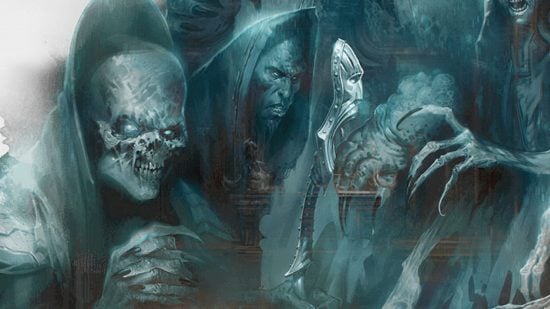
Phantom 5e
| Rogue Level | Subclass Feature |
| 3rd | Whispers of the Dead, Wails from the Grave |
| 9th | Tokens of the Departed |
| 13th | Ghost Walk |
| 17th | Death’s Friend |
Found in: Tasha’s Cauldron of Everything
The Phantom 5e is a shadowy Rogue, touched by the plane of death. Their abilities are connected to the dead, and, particularly, to the spirits of creatures that die around them. Fortunately, there won’t be any shortage of those…
Whispers of the Dead allows the Phantom to gain any skill or tool proficiency from their communion with the departed once per short or long rest. This makes Phantoms extremely versatile: give them an hour and they’ll have a +2 bonus to any skill check.
Wails from the Grave is a useful combat trick. A number of times equal to their proficiency bonus per long rest, when they successfully deal Sneak Attack damage, the Phantom can target another creature within 30′ of the first and deal half as many Sneak Attack dice (rounding up) in Necrotic damage.
This damage doesn’t need to hit and doesn’t allow a save, so it’s a good way to put damage on targets with high AC or magical defenses. Just sneak attack a goon with low AC and a stack of hit points, and chain damage into their tougher-shelled boss. It’s also a convenient way to finish off targets hanging in the fight by a single hit point.
At ninth level, Tokens of the Departed grants the ability to crystallize the spirit of creatures that die within 30 feet into a Soul Trinket as a reaction, provided the Phantom has a free hand. They can carry up to their proficiency bonus in Soul Trinkets. These give advantage on death and Constitution saving throws while on the Phantom’s person, and can be crushed to provide extra charges for Wails from the Grave or to ask a question of the spirit trapped within.
Unless you capture the soul of someone you really need to speak to in a trinket, you should aim to constantly burn through your Soul Trinkets in a fight – chaff enemies and fragile skirmishers will die quickly if you keep spending your Soul Trinkets, and will fill those charges back up for you.
Scout 5e
| Rogue Level | Subclass Feature |
| 3rd | Skirmisher, Survivalist |
| 9th | Superior Mobility |
| 13th | Ambush Master |
| 17th | Sudden Strike |
Found in: Xanathar’s Guide to Everything
Want to play a wilderness character, but don’t want to touch magic? Always felt that it was weird that Rangers had magic spells? Really miss playing tag or bulldog on the playground? The Scout 5e is the Rogue subclass for you.
Scouts are adept in nature, gaining a double proficiency bonus in Nature and Survival from the Survivalist feature. Don’t forget that Nature proficiency has a combat application, as you can use it to extract the venom from slain or incapacitated venomous creatures, even without a poisoner’s kit.
Scouts are extremely mobile, even by the standards of Rogues. The Skirmisher feature gives them a new reaction, allowing them to move up to half their speed without provoking opportunity attacks when an enemy ends its turn within five feet of them.
You only get one reaction per turn, and, once you get Uncanny Dodge at level five, you’ll sometimes have a hard choice between reducing the damage from a big hit, or using Skirmisher to get out of the way. Skirmishing away is the right defensive choice if it puts you out of engagement range of other enemies who haven’t yet closed the distance, and it’s the right offensive choice if it will bring you closer to a high-value target.
At higher levels, Superior Mobility will increase all your movement speeds by ten feet (including swimming, climbing and flying), while Ambush Master gives you advantage on Initiative rolls, and grants all your allies advantage on hit rolls against the first enemy you hit in the first round of combat. Use this to scalpel out a priority enemy or, if they’re particularly chunky, let your team layer them with debuffs so they hardly participate in the fight.
Races like the Wood Elf and Deep Gnome, which have advantages to hide checks in certain terrain types, can make untouchable Scouts in the right environment, using Skirmish to disengage from foes during the enemy turn, then Hiding easily as a free action on their turn, so they can immediately launch a ranged Sneak Attack with advantage.
Or, if you want a combat-focused Rogue that bounces around the battlefield like a pinball, the Mobile feat grants another 10″ of movement, the ability to ignore difficult terrain when Dashing, and immunity from opportunity attacks made by any enemy that the Rogue has targeted with a melee attack.
Soulknife 5e
| Rogue Level | Subclass Feature |
| 3rd | Psionic Power, Psi-bolstered Knack, Psychic Whispers, Psychic Blades |
| 9th | Soul Blades: Homing Strikes, Psychic Teleportation |
| 13th | Psychic Veil |
| 17th | Rend Mind |
Found in: Tasha’s Cauldron of Everything
What’s cooler than fighting with a blade in each hand? Fighting with a psychic blade in each hand.
The Soulknife 5e has a pool of Psionic Energy dice that can be expended to use psionic abilities. They have a pool of these equal to twice their proficiency bonus to spend every long rest, though once per long rest they can also use a bonus action to recoup a single die. These start as d6 but increase in size as they level up.
Psi-Bolstered Knack allows them to add the result of a Psionic Energy die to the result of a failed check with a skill or tool they are proficient in, only expending the die if they pass the roll. This makes them very dependable in their specialized skill domain.
Psychic Whispers lets them create a telepathic link with a number of creatures equal to their proficiency bonus, that they can see, for a number of hours equal to the roll of one Psionic Energy die. The first Psychic Whispers per long rest is free, too, so they can set up the link before setting off on any solo stealthing.
Psychic Whispers could easily be overlooked as a combat ability. Feeding the party up-to-the-minute combat data on an enemy you’re reconnoitering lets you set up perfect ambushes.
Capitalize on this by choosing Expertise in Athletics to help maneuver into a vantage point, or a class like the Tabaxi or Aarakocra with special movement speeds, and load points into Wisdom for Perception checks to ensure you don’t miss a thing.
The title power of the Soulknife is its Psychic Blades, which allow them to manifest a psychic blade in one or both of their hands whenever they take the attack action: these are finesse melee weapons that can be thrown up to 60 feet- the first deals d6 psychic damage, while the second deals d4.
At first sight, these blades might seem underwhelming; they’re basically a shortsword and dagger. But a Soulknife can never be disarmed, never has to draw or drop a weapon, and always has their hands free at any time other than when they’re attacking. Compensating for the fact the blades can’t be replaced with +1 or better magical weapons, at ninth level the Soul Blades ability allows the Soulknife to expend Psionic Energy dice to bolster the attack roll on a missed attack, or teleport to a spot that they target with the knife.
The Soulknife is first to the draw in any combat that starts with weapons sheathed, and will always pass muster when patted down by a bodyguard. Just remember that they aren’t actually armed, except when they’re attacking, so they can’t gain the +1AC bonus from the Dual Wielder feat.
Swashbuckler 5e
| Rogue Level | Subclass Feature |
| 3rd | Fancy Footwork, Rakish Audacity |
| 9th | Panache |
| 13th | Elegant Maneuver |
| 17th | Master Duelist |
Found in: Xanathar’s Guide to Everything
Fancy a dashing, rather than dastardly rogue? The swashbuckler channels the spirit of expert and charming duelists like the Three Musketeers or Errol Flynn’s sword-dueling Robin Hood.
Fancy Footwork prevents any enemy that the Swashbuckler 5e has made a melee attack against from taking opportunity attacks against them. This allows the Swashbuckler to pick and choose their melee battles; remember that Rogues can use Dash as a bonus action, and you can make your attack(s) at any point during your moves, so a Swashbuckler has plenty of options: darting into and out of engagement range with a slow-moving enemy, or landing a drive-by attack, as they run past a guard towards their real target.
Rakish Audacity gives two more compelling bonuses. Swashbucklers add their Charisma bonus to initiative rolls, helping them to set the terms of combat. But, more importantly, they can make Sneak Attacks against enemies they don’t have advantage against, provided they’re within 5′, don’t have disadvantage, and no other allies are within 5′ of them. They’re deadly duelists.
As they won’t usually be attacking with advantage, Swashbucklers need to dual wield more than most Rogues to ensure they land a hit and trigger that Sneak Attack damage. The Dual Wielder feat is a great companion, giving them +1 AC and allowing them to dual wield weapons that aren’t light (a pair of Rapiers is the ideal choice).
The ninth-level feature Panache allows them to turn on the charm, making a Charisma (Persuasion) check as an action to change the mood of a creature. If they’re not an enemy, this works like a magic-less version of the Charm spell.
If they are an enemy, they have disadvantage on any attacks they make against anyone other than the Swashbuckler. This lasts for a minute or until one of your allies intercedes and breaks off the duel.
Make sure you don’t bite off more than you can chew – the Swashbuckler is still a squishy Rogue. Your goal is to get into duels you can win, not pull heat away from the rest of the party.
Here’s a complete guide to the DnD Swashbuckler 5e subclass.
Thief 5e
| Rogue Level | Subclass Feature |
| 3rd | Fast Hands, Second-Story Work |
| 9th | Supreme Sneak |
| 13th | Use Magic Device |
| 17th | Thief’s Reflexes |
Found in: Player’s Handbook
In the very first paper pamphlet for Dungeons and Dragons, the OG Rogue was actually called the Thief. The Thief 5e subclass brings back that flavor, with a Rogue who brings archetypal Rogue exploration abilities into combat.
The starting ability Second-Story Work makes Thieves faster climbers and gives them a longer running jump, while Fast Hands adds Sleight of Hand checks, disarming traps, opening locks and ‘Using’ objects to the list of things they can do with a Bonus Action. If you’re fighting in a chamber with a ceiling gradually descending to crush you, having two attempts to disarm the trap per turn (or one attempt and a combat action, if there are enemies in the room too) will certainly help the party’s chances of success.
Likewise, scarpering into the rafters to shoot your enemies from above, or spending the surprise round of a battle on two Sleight of Hand checks to remove a Wizard’s component pouch and replace it with a bag of Essence of Ether, can make for entertaining combats.
At higher levels, Thieves become sneakier and capable of using magical items without meeting any prerequisites (another call-back to earlier versions of Rogues) – they’re a real love letter to the past. But leveraging their abilities into combat advantage relies on your DM providing interesting combat scenarios and arenas. You’ll get the most from them if you love being creative, and your GM is supportive.
Rogue 5e builds
Though all Rogues share a core skillset of sneaking and stabbing, and there’s never a good reason not to buff up your Rogue’s Dexterity, they’re still an incredibly varied class with deep specialisms. Here are a few Rogue 5e builds to try out:
Deep Gnome Magehunter
With a high damage output, the ability to reduce the damage from area-of-effect spells, and mobility to choose their own position on the battlefield, Rogues are well-placed to hunt out fragile mages who prefer to stay on the fringes of the battlefield. This Arcane Trickster aims to ensure that enemy casters get no sleep, and will be cathartic to play for anyone who’s ever lost a treasured hero to a well-placed spell.
Ability Scores
As ever, Dexterity is your most important stat, followed by Intelligence, which will be your spellcasting ability. Wisdom and Constitution are good choices to follow, as they will boost your survivability against enemy magic.
Details
- Pick the Deep Gnome subtype as your race, granting you +2 Int, +1 Dex, 120 feet of darkvision, and the ability to hide when only lightly concealed by rocky terrain. As a gnome, you gain advantage on all Charisma, Intelligence and Wisdom saves against the effect of magic, sure to irritate any wizard you’re up against.
- Pick a background that provides Arcana skill proficiency (such as a Sage or Cloistered Scholar) and gain Expertise in it. You need to be able to identify spells and enchantments to successfully infiltrate a Wizard’s magically defended sanctum.
- Kit yourself out with as much of the standard Rogue gear as you can afford – studded leather armor for 12+ Dex Bonus AC, two shortswords, and a bow, each dealing d6 piercing damage. While you’re at it, see if you can’t acquire some live bookworms and some disappearing ink. Nothing tells a Wizard you’ve got it out for her like putting bookworms in her library.
- When you hit level three, pick the Arcane Trickster subclass. You’ll automatically gain the Mage Hand 5e cantrip and should pick Lightning Lure and Booming Blade as your other cantrips. The aim here is to drag unwary Wizards towards you using Lightning Lure and then hit them with Booming Blade, so that trying to escape punishes them.
- You’ll gain three first-level Illusion and Enchantment spells. Pick Sleep, a truly classic tool for rendering weak enemies unconscious, and Color Spray, a tool that can blind enemies for a turn without any saves allowed. It’s a nice combat opener, or the ultimate smoke bomb to make good your escape.
- At fourth level, pick up the Mage Slayer Feat. Spellcasters you harm have disadvantage on their Concentration check to maintain spells, you can make a reaction attack whenever they cast a spell within five feet of you, and you’ll gain advantage on saving throws against spells cast by creatures within five feet of you. Once you close with a mage, whether they try and run, or try and stay, you’ll be able to attack them.
- At level seven, make sure you pick up Hold Person. This will paralyze your target, giving attacks against them advantage, and turning hits from attacks made within five feet into automatic criticals.
- At eighth and higher levels, boost your Dexterity and Intelligence to make your spells harder to resist, and consider the Svirfneblin Magic racial feat to add a suite of deceptive spells to your toolbox that won’t use up your spellcasting slots.
- From ninth level, your enemies will have disadvantage on saves against any spells you cast from hiding, so let that bonus guide your choices – though you’re best off avoiding spells that allow an Intelligence save, as this is where your prey of choice will be strongest. Crown of Madness is an interesting tool to turn a spellcaster’s bodyguards into a liability.
- At level eight, 14, and 20, you’ll be able to pick a spell from any spell list; it’s hard to beat Fireball for your level 14 pick. Although you get it well after the Wizard, your enemies will suffer disadvantage on their attempts to escape it.
Paranoid Poisoner
This Variant DnD Human doubles down on the Assassin’s main focus – opening combat with a deeply unfair round of attacks that your enemy doesn’t see coming.
Ability Scores
Dexterity is your primary stat and should be where you focus your stat increases, followed by Charisma, which will help you to sell your lies. Wisdom will make your character more perceptive, but, because of the Alert feat you’ll pick early on, it’s not critical to protect you from Sneak Attacks. Constitution may be useful, in case you have a mishap with any of your poisons!
Details
- Pick Variant Human as your race, choosing +1 Dex, +1 Cha, and the Alert feat, which grants you +5 to initiative rolls, makes you immune to surprise and means that attacks from unseen enemies don’t have advantage against you. The Criminal background will give you relevant skill proficiencies, and access to the underworld to purchase illegal substances…
- Make sure you have skill proficiency and Expertise in Deception and Stealth. Your ideal fight begins with you unnoticed by your enemies, or with them believing you’re one of their allies.
- Kit yourself out with throwing darts, daggers, a pair of shortswords, and the best light armor you can afford. You’re saving your money to buy a poisoner’s kit and a disguise kit by level three.
- At level three, choose the Assassin subclass, and buy that poisoner’s kit. You’ll now have advantage on attacks against enemies who haven’t acted yet in combat – which should happen often thanks to your Alert feat – and you can brew a weak poison to apply to your weapons.
- At level four, take the Poisoner feat from Tasha’s Cauldron of Everything. You already have proficiency with the poisoner’s kit, so convert that into proficiency with a forger’s kit – but, more importantly, you now ignore enemy resistance to poison, and, for 50gp, you can brew a number of doses of potent poison equal to your proficiency bonus.
- Your combat strategy from here on out is to open combat with a surprise round, and hopefully high up on the initiative track. You’ll unleash a flurry of poisoned dart attacks, all made with advantage. A round where you land both darts will do 2d4 + 2d6 damage, and twice force the enemy to make a DC14 Con save or take 2d8 poison damage. And that’s just at level four.
- From here on, increase your Dexterity as much as possible, and get ready to use your Infiltration Expertise at level nine to create a fake identity, for when the DM starts sending bounty hunters after your character…
Tabaxi Swashbuckler
With natural agility and feline charm, this swashbuckler is an elegant duellist. This build doubles down on the Tabaxi’s speed and the Swashbuckler’s maneuverability,
Ability Scores
Dexterity and Charisma are your focus here, as Dexterity is always useful for a Rogue while Charisma is the basis for your subclass’ special features. As a Tabaxi, you have a climbing speed, so feel free to leave Strength as your dump stat, as you won’t need it for either your attacks or to climb around – just stay out of the water.
Details
- Pick Tabaxi as your race, granting you +2 Dex, +1 Cha and a package of other useful abilities
- Choose a pair of shortswords as your weapons for d6 damage attacks, as well as the best leather armor you can afford. You’ll upgrade to the rapiers soon enough.
- At level three, choose the Swashbuckler subclass. This is where your game plan takes shape: with Fancy Footwork you can move past any enemy you make a melee attack against, without provoking an opportunity attack. With a weapon in each hand, you can attack (and therefore dodge) two enemies each turn, and with the Tabaxi’s Feline Agility you can effectively make a Dash move without using your bonus action.
- Meanwhile, Rakish Audacity lets you make Sneak Attacks against enemies you are dueling one on one. With your incredible maneuverability, you should always be able to set this up.
- At level four, take the Dual Wielder feat so you can upgrade your shortswords to rapiers, increasing their damage die to d8 and granting you +1AC.
- After this, your main choices are whether to increase your Dexterity, Charisma, or take additional feats. It’s hard to argue with better Dexterity for a Rogue, so start there.
- Piercer is a good choice, as it allows you to add 1 to your Dexterity, and increases the reliability of your melee attacks, letting you reroll one damage die in each attack once per turn, and granting you a bonus die on your critical hits.
- Defensive Duelist allows you to react to a melee attack that hits you while you’re wielding a finesse weapon, by adding your proficiency bonus to your AC. This one can feel like a gamble, as you won’t know until you use it whether the bonus will stop the attack from hitting – but if you see a low result on your enemy’s attack die, you’ll feel like a true swordsman when you successfully parry.

One DnD Rogue
There is already another version of the DnD Rogue in playtesting. It’s worth taking a minute to consider ‘One D&D‘, the next version of the core rulebooks arriving in 2024.
What’s new
The latest version of the Rogue can be found in Player’s Handbook Playtest Six (you can see a summary of the Rogue’s features in the video above).
On the whole, things look very familiar. The only ability the Rogue loses is Blindsense (a cut that was made in previous playtesting), and several new features have been introduced. These include:
- Weapon Mastery – A new addition to D&D that allows characters to access the unique features of specific weapons they’ve trained with.
- Steady Aim – Spend a bonus action to gain advantage on your next attack roll.
- Cunning Strikes – Adds effects like ‘Disarm’ and ‘Poison’ to a successful Sneak Attack.
- Devious Strikes – Even more Sneak Attack features, including ‘Daze’, ‘Knock Out’, and ‘Obscure’.
Sneak Attack has also been tweaked in general to allow you to use it outside of your turn. The only other major change is that Reliable Talent has moved to a different level to make room for all these new features – much of Playtest Six undid changes to the Rogue that were made in the previous playtest.
For the latest on Dungeons and Dragons, here’s everything coming up in the DnD 2023 release schedule. And if you want to try a new game, here’s the best tabletop RPGs to try right now.
